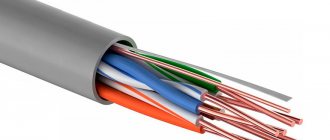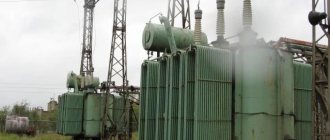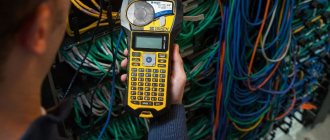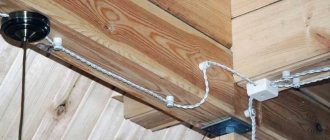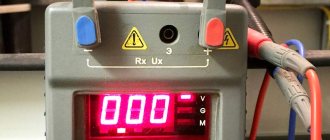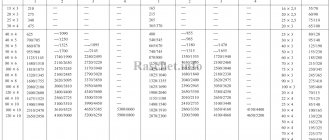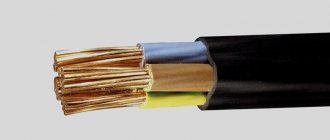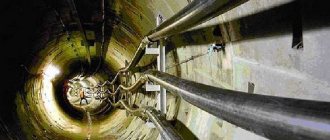Wire marking is a very important element in indicating the characteristics of electrical conductive materials, which is important for their correct and safe use. Today there are a large number of wires and cables that differ in both design and functional features. To determine these characteristics, appropriate color coding and alphabetic abbreviations are used, deciphering which can cause great difficulty even for experienced electricians.
Tables
All photos are clickable. Click to enlarge.
Marking of Russian cables:
- Power cables with PVC and rubber insulation.
- Control cables
- Cable with BPI - impregnated paper insulation
Domestic wires and cords:
- Explanation of markings and abbreviations of wires: KSPV, KPSVV, KPSVEV, PNSV, PV-1, PV-3, PVS, ShVVP, PUNP, PUGNP.
- Suspended wires: A, AC, SIP, Ng
- Power, installation wires and connecting cords.
- Installation wires
Marking of foreign cables:
- Power cable
- FROR Italian cables: Italian standard CEI UNEL 35011
- Control cable
- Halogen-free fire-resistant cable
- Cables with cross-linked polyethylene insulation
Foreign wires and cords:
Mounting wires:
Installation wires from foreign manufacturers
Brands and functions of some wires:
Well-known brands and applications of cables:
Areas of application for popular cords:
General principles for marking cable products
The basic standards and principles for marking wires and cables are similar. At the same time, there is no great difficulty in decoding. The main thing is to remember a few rules.
To identify cable products, markings are used, consisting of 7 groups, including letters and numbers. The code looks like this: X ХХХ ХХХ ХХХ ХХХ ХХХ ХХХ.
Each numerical and alphabetic value is written in a strictly designated order. Stands out:
- 1 group. It indicates the material of the veins.
- 2nd group. The material used to make the armor, protection, core insulation or sheath is indicated here. The marking of the armored cable is also indicated here.
- 3rd group. Design features are indicated (these may include the possibility of using the product for installation in the ground or pipes).
- 4th group. It has a numerical indicator, which means the number of cores located in the cable. The absence of a number indicates that she lived here alone.
- 5 group. Refers to the cross-sectional area, which is expressed in mm².
- 6 group. From this characteristic you can find out the rated network voltage.
- 7 group. At the end of the marking the standard according to GOST or TU is indicated.
general information
Cable marking makes it possible, when installing electrical networks, to find out such operating parameters of the conductor as core material, thickness, design voltage, functional purpose of the cable, material and flammable characteristics of the insulating sheath, and other features.
The designations “wire” and “cable” are, in principle, synonymous; the difference between them is determined only by the scope of application. Thus, wires are usually used to distribute electrical wiring under light load conditions, and cables are used to conduct electricity from power plants and in highly loaded networks; therefore, they are heavier, as they are equipped with good protection. There is also a category of “cords” - this is a flexible conductor with twisted conductors, used in the design of electrical appliances for mains power. Cords, as a rule, lack overall insulation.
Despite the fact that the marking of wires and cables may have different letter designations in alphabetical order and case, it is always carried out in accordance with the general principle. First comes a description of the functional and design features using letters. For example, PUNP - wire (P) universal (UN) flat, and then digital markings of the number of cores and cross-sectional area of the conductors. Here the decoding of PUNP 3×1.5 means that this flat universal wire consists of three current-carrying wires with a cross-section of 1.5 mm2. The order of letters in the abbreviation depends on the strictly established GOST standard, and the thickness and number of cores must always come after them. After these data there is a designation of the climatic operating conditions (if there are any special features), and then the specifications or GOST according to which the cable products were manufactured.
According to the conditions under which and for what purposes conductors are used, they are divided into:
- power – used when laying electrical wiring;
- control - installed in the wiring that serves to transmit signals;
- control cables – installed in systems and circuits that control the operation of automatic systems;
- radio engineering – used in radio engineering installation.
Purpose of marking
The marking contains letters that indicate the material of the cores and insulation, the elasticity of the wire and the type of construction.
When purchasing electrical installation equipment, you should understand what the letters and numbers in the name mean. This code is a marking that gives the electrician the following useful information about the conductor:
- Material of manufacture of cores, their number. The most commonly used are aluminum and copper conductors with one or more cores.
- Type of insulation. Shows what material the insulating layer is made of.
- Conductor cross section. This indicator directly determines what load can be connected to the wire. Copper and aluminum conductors with equal cross-sections can withstand different loads.
- Nominal electrical values. These are operating voltage, current, power.
- Resistance to environmental factors. For outdoor use, models are resistant to moisture, ultraviolet radiation, and mechanical stress. Household conductors are typically installed in a distribution panel or cabinet, on or within walls, so they do not require a high level of shock resistance.
- Design.
- Flexibility.
The marking may also indicate the type of conductor - cable, electrical wire or cord. A wire is understood as a product made from a monolithic or multi-wire current-carrying component with insulation or its absence. A cord is several stranded insulated wires that are used to connect electrical appliances to a power point. A cable is a product with both single-core and multi-core wires, with insulation, armor or other design features. They are distinguished by purpose - power, control, used in radio frequency installations. Cable types, types of wires and designations must be present both on the conductor itself and in the documentation for it.
Labeling varies. There is domestic and foreign - the principle of decoding is the same, only the letters differ. The material used is the same. There is also a color designation for the wires. Among domestic products you can always find an analogue of a foreign conductor and vice versa.
Deciphering the markings
Deciphering the characteristics of a wire or cable begins with the symbolic marking applied by the manufacturer to the insulation - it usually contains comprehensive information about the materials from which the conductor is made and other parameters. The order of symbols and their meanings are established by GOST, with the exception of situations when conductors are made
So, the first letter in the marking of any cable indicates the metal of the cores, but it is not always placed. The fact is that only aluminum wires are marked with a capital letter “A”. And if there are copper conductors, no marking is applied.
The second (in copper wires - the first) letter in the marking allows you to find out the purpose of the cable. The following codes are used here:
- P – flat;
- M – installation;
- Ш or П(У) – installation;
- MG – installation cable with flexible cores;
- K – control.
The third letter in the marking of electrical conductors serves to designate the insulating material of the conductors. Their variety is quite large:
- V/VR – polyvinyl chloride shell;
- R – rubber is used to insulate the cores;
- N/NR – fire-resistant rubber or nayrite;
- K – nylon shell;
- L – varnished insulation;
- P – polyethylene;
- F – fold;
- E – enamel;
- Ш – polyamide type silk;
- O – polyamide silk insulation is braided;
- E – shielded insulation;
- G – insulating shell with flexible conductors;
- C – fiberglass;
- T – the insulation design includes a support cable.
The marking of a rubber insulated cable, which has additional protection made of nayrite or PVC, is done as follows: first indicate the above symbols, and then the marking of the cores.
The decoding of the following symbol makes it clear what design features this cable has. According to the current GOST, these are the following letters:
- A – asphalted cable;
- B – cable with armor tapes;
- G – flexible wire without protection;
- K – cable armored with round wire;
- T – wire intended for laying in pipes;
- A – the cable has additional braided protection.
The abbreviation frls at the end of the cable marking refers to the degree of compliance with fire safety requirements. FRLS is formed from two abbreviations that describe the characteristics of conductor materials: FR - fire resistance, LS - low smoke emission. Thanks to this, the frls cable does not support combustion even when laid in a group, and even remains operational for some time in fire conditions (this is important, for example, for the operation of a fire protection system). Most often, the frls version uses cables VVGng-FRLS (power), KPSEng(A)-FRLS, KSBNG(A)-FRLS (cables for fire protection systems).
Wires and cables are marked with letters
The first letter is the core material:
- A - aluminum
- No letter - copper
The second letter is in the wire designation:
- P - wire (PP - flat wire)
- K - control
- M - mounting
- MG - mounting with flexible core
- P(U or Sh) - mounting with flexible core
The third letter is in the designation of wire and cable; core insulation material:
- B or BP - polyvinyl chloride (PVC)
- P - polyethylene
- R - rubber
- N or NR - nayrite (non-flammable rubber)
- F - folded (metal) shell
- K - nylon
- L - varnished
- ME - enameled
- O - polyamide silk braid
- Ш - polyamidone silk insulation
- C - fiberglass
- E - shielded
- G - with flexible core
- T - with support cable
The rubber insulation of the wire can be protected by sheaths: B - polyvinyl chloride, N - nayrite. The letters B and H are placed after the designation of the wire insulation material.
The fourth letter is design features:
- A - asphalted
- B - armored tapes
- G - flexible (wire), without protective cover (power cable)
- K - armored with round wires
- O - braided
- T - for installation in pipes
In addition to letter designations, brands of wires, cables and cords contain digital designations: the first digit is the number of cores, the second digit is the cross-sectional area, the third is the rated voltage of the network. The absence of the first digit means that the cable or wire is single-core. The cross-sectional areas of the cores are standardized. The values of the cross-sectional areas of the wires are selected depending on the current strength, the material of the cores, and laying conditions (cooling).
The designation of cords must include the letter Ш.
Features of marking of individual cable types
The marking of power cables, as well as control cables and cables with PPI (impregnated paper insulation), may include separate symbols that indicate operational and design features.
For power cables (in accordance with GOST 16442-80):
- AA denotes a conductor with aluminum cores in an aluminum sheath;
- AC - similar to AA, only with a lead sheath;
- B – the cable is equipped with armor made of two tapes, which are coated with anti-corrosion material;
- B – the insulation of current-carrying conductors is made of polyvinyl chloride (it comes first in the marking of copper wires, for example, in the VVG cable);
- B – general insulating sheath made of polyvinyl chloride (ranks second in the marking of copper wires, like VVG);
- G – in this situation means “naked”, that is, the cable does not have a protective layer over the armor;
- ШВ – a cable in which the function of a protective layer is performed by an extruded polyvinyl chloride hose;
- ШП – cable with a protective layer of extruded polyethylene hose;
- K – cable with armor made of galvanized round wires (on top of them there is a protective layer);
- C – lead shell;
- O – a separate sheath is applied on top of each of the phase conductors;
- P – conductor with rubber insulation;
- P - sheath or insulation of cores made of polyethylene;
- PS - “S” means “self-extinguishing” - the polyethylene insulating shell does not support combustion and does not spread fire;
- PV – the insulation material is vulcanized polyethylene;
- NR - cable with flame retardant rubber insulation;
- NG - a cable with this designation does not support combustion (sometimes indicated in capital letters, for example, VVG ng);
- LS – stands for the English phrase low smoke, that is, a material with reduced smoke emission;
- NG-LS - insulation material emits little smoke and does not support combustion;
- FR – specific cables with fire-resistant insulation;
- FRLS - a modification that includes both high fire resistance and low smoke emission;
- E – the cable design includes a shielding layer of spiral copper wire;
- KG – flexible cable.
Common examples of cables with this marking are VVG, VVGng, VVG ng-LS, SIP, China, FOLS, VVGng-frls.
For cables with impregnated paper insulation (according to GOST 18410-73):
- The marking of aluminum wires begins with the symbol “A”; copper wires do not have any designation;
- B – equipped with armor made of steel flat strips (placed after the designation of the shell material);
- AB - armor made of aluminum;
- SB - lead armor;
- C – lead cable sheath;
- O - written to designate separately galvanized cores;
- P - steel armor wires have a flat shape;
- K – round-shaped steel wires in armor construction;
- B – if it appears after the dash at the end of the marking, it means BI with depleted impregnation;
- l – lavsan tape in the pillow design;
- 2l – double lavsan tape in the pillow design;
- d – “bare” cable without a protective layer;
- n - stands after the designation of armor and means that the outer layer does not burn;
- Shv and Shp - similar to the marking of power cables;
- (ozh) – single-wire conductors (placed at the end);
- U - stands at the end of cables with BPI and high heating temperature;
- C – the paper insulating layer of the cable is impregnated with a non-draining solution.
For control cables (in accordance with GOST 1508-78):
- the initial symbol, similar to previous standards, either means aluminum conductors (A) or is not written;
- B – the cores are insulated with polyvinyl chloride;
- B – general PVC sheath;
- P – polyethylene insulating shell (PS, if made of self-extinguishing material);
- G – naked;
- R – rubber insulation of cores;
- K – indicates the purpose (placed first for copper cables);
- KG – flexible;
- F – fluoroplastic insulation;
- E - in the middle of the marking indicates a shielded conductor, and at the beginning - for laying in mines.
Imported cables
The marking of cables from foreign companies naturally includes different symbols and their groups, the interpretation of which may depend on the purpose of a particular conductor.
For cables with XLPE insulation:
- N – is present in all wires in front of the abbreviation, means that the conductor meets the requirements of VDE (Union of German Electrical Engineers);
- Y – insulation of current-carrying conductors made of polyvinyl chloride;
- 2Y – polyethylene insulation;
- 2X – insulation is made of cross-linked polyethylene;
- S – the cable is equipped with copper wire shielding;
- (F) – conductor with longitudinal sealing;
- (FL) – with longitudinal and transverse sealing;
- E – three cores in the cable structure;
- R – steel armor made of round wire.
Halogen-free flame retardant:
- N – VDE compliance;
- NX – insulating layer made of cross-linked rubber;
- C – copper shielding;
- FE 180 – the cable maintains the integrity of the insulation during a fire for 3 hours (without installation with a fastening system);
- T 90 – maintains integrity for 1.5 hours when installed with a fastening system.
Power:
- N – corresponds to the standard of the Union of German Electrical Engineers;
- Y – polyvinyl chloride insulation;
- H – the plastic compound used for insulation contains no halogens;
- M – installation specialization of the conductor;
- C – the design has a copper screen;
- RG – presence of armor in the composition.
Mounting:
- H – wire made in accordance with HAR, harmonized;
- N – conforms to VDE standard;
- 05 – designed for operation under voltage 300/500 V;
- 07 – designed for operation under voltage 450/750 V;
- V – polyvinyl chloride insulation;
- K – the presence of a flexible core required for permanent installation.
Optical cables
It should be noted that the optical cable has a marking determined solely by its manufacturer, since no general standard has been adopted in this matter. This problem is typical only for Russian optical cable manufacturers, since European and American companies have already come to a single standard. FOCL (fiber optic communication lines) today are at the forefront of information transmission methods. FOCLs combine good transmission range, low losses, high protection against damage and electromagnetic fields. Due to the fact that fiber-optic lines are rapidly gaining popularity in our country, we can expect the speedy approval of standard optical cable markings in accordance with GOST. Today, when installing fiber-optic lines, the following conventional order of cable designation is used (according to the order of the symbols in the marking):
- Type of cable. Either OK (optical cable) or OKV (OK intra-facility).
- Shell material. N – flame retardant; G – upon contact with fire, does not emit halogens or smoke; T – made of tracking-resistant material.
- Armored cable cover. C – corrugated steel tape; A – high-strength aramid threads; O – steel wire braid; P – core strand made of fiberglass; B – braided wire made of galvanized steel (in 1 or 2 layers).
- External load-bearing element. /A – aramid; /P – fiberglass rod; /T – wire or cable made of steel.
- Numerical designation of the number of cables of the same type connected together (1,2,3...).
- Core design. T – central module; M – layering of modules.
- Number of elements in a layer or parallel modules (1,2,3...).
- The central strength element in the core. T – steel rope or wire coated with a polymer material; P – fiberglass rod with or without polymer coating.
- Number of optical fibers of one type (1,2,3...). Groups of different types are separated by a fraction.
- Optical fiber type. E, A, N, G – single-mode; M – multimode with a core diameter of 50 microns; B – multimode with a core diameter of 62.5 microns.
- Calculated tensile force (... kN).
To ensure the efficiency and safety of operation of fiber-optic lines, it is required that the marking of the optical conductor contain the year of manufacture, measurement marks and the trademark of the enterprise.
Cable type: twisted pair
Why are clauses 1.1.29 and 1.1.30 of PUE 7 incorrect?
What about PUE 7? Paragraphs 1.1.29 and 1.1.30 contain irrelevant and even erroneous requirements for color marking of conductors.
Let's consider clause 1.1.29 of PUE 7:
We see that the requirements of clause 1.1.29 of PUE 7 generally comply with the provisions of GOST R 50462–92, which is no longer in force. And this is no longer correct, since they must comply with the requirements of GOST 33542.
Let's consider clause 1.1.30 of PUE 7:
And the requirements of clause 1.1.30 of PUE 7 contradict the requirements of not only modern GOST 33542–2015, but also all its previous variations - GOST R 50462–2009, GOST R 50462–92 and even GOST 12.2.007.0–75 and, thereby, create conditions for electric shock.
- For example, this paragraph says that you can use separately yellow and separately green colors to color-code phase busbars.
As we already know, GOST R 50462–2009 and GOST 33542–2015 directly prohibited the use of these colors separately in order to comply with electrical safety requirements, since situations could arise when it was possible to confuse protective busbars with yellow-green markings and phase busbars with yellow or green colors.
Clause 6.2.1 from GOST 33542–2015
2) Busbars, which are one of the options for conducting conductors, are usually used in low-voltage switchgear, which are manufactured and certified in accordance with the requirements of national standards, which establish that the color identification of conductors must comply with the requirements of GOST R 50462–92 or GOST R 50462–2009, or GOST 33542.
3) The simultaneous use of blue and cyan colors to identify the pole and middle busbars will inevitably lead to a dangerous situation, since the pole busbar can be under voltage of 110, 220, 440 V or more, and the middle busbar is under voltage almost equal to zero. Moreover, GOST R 50462–92 considered blue and light blue as one color.
4) Phase conductors in the requirements are designated by the letters “ A , B , C ”. However, in IEC standards and national standards developed on their basis, phase conductors are designated differently - “ L1 , L2 , L3 ”.
These and other errors in these paragraphs arose due to the fact that the requirements of clause 1.1.29 of the PUE 7th ed. were formulated on the basis of the requirements of GOST R 50462–92, and the requirements of clause 1.1.30 of the PUE 7th ed. were rewritten from clause 1.1.29 of the PUE 6th ed. sample 1985. That is, errors are rewritten from year to year and no one bothers to correct them.
Brands of conductors and their purpose
Power cable VVG and its analogues
One of the most popular conductors today, used in installations for various purposes, is VVG. It is distinguished by a good combination of performance characteristics and an affordable price. In fact, the decoding of VVG sounds like “vinyl-vinyl-naked.” For the most part, VVG is produced with copper conductors, because cables with aluminum conductors are not recommended by the PUE. This is the most popular power cable in Russia and the CIS countries. There are also the following brands of cables for this purpose:
- AVVG with a number of cores from 1 to 4 and a cross section of each 2.5-50 mm2. The design includes aluminum conductors (the only difference from the standard VVG), sheath and PVC insulation. Used for open installation using sun protection channels.
- AVRG – from 1 to 4 cores with a cross-sectional area from 4-300 mm2 or 2.5-300 mm2. Power cable with aluminum core, rubber insulation and PVC sheath. Designed for laying over the air, overpasses, bridges and channels.
- ANRG. It has a similar design and core material, but differs in the presence of an oil-resistant sheath made of non-flammable rubber and rubber insulation. It is laid through channels, air, tunnels, bridges and overpasses.
- VVG - has 1-4 copper cores with a cross-sectional area of 1.5-50 mm2. It is laid outdoors along sun protection channels. It operates in a wide temperature range and is highly resistant to mechanical and atmospheric influences.
- VVGp is an analogue of VVG, differing only in the presence of flat conductors.
- VVGz - differs from VVG in that between the cores (insulated separately from each other) the space is filled with rubber material or plyvinyl chloride strands;
- VRG is a flexible cable with a copper core, PVC sheath and rubber insulation. It is used under the same conditions as VVG.
- NYM is a power cable that complies with foreign standards (VDE). Well protected from moisture and heat, but not resistant to sunlight.
- KG is a flexible cable with twisted copper conductors, which transmits alternating current up to 660V and 400 Hz. Most often used to power powerful electrical appliances.
- VBBShv – used to power stationary installations. It has good heat resistance and the ability to work at 98% humidity.
- AVBBSHv - analogue of the previous brand with aluminum conductors;
- VBBShvng - does not spread fire and does not ignite;
- VBBShvng-LS is an analogue of VBBShVng, the materials of which do not emit smoke and harmful substances when heated.
SIP cable
SIP stands for “self-supporting insulated wire”. It is recommended for use as a power conductor in overhead power lines (OHL). There are several brands of SIP with different performance characteristics; to distinguish them, they put a digital designation at the end of the marking:
- SIP -1 or -2 is designed for use in overhead lines with a voltage of 660/1000 V (50 Hz).
- SIP – 3 is used when installing overhead lines with voltage from 10 to 35 kV (50 Hz).
- SIP-4 are used when distributing electrical networks along the walls of engineering structures, buildings, and connecting overhead lines to the input.
The use of one or another brand of SIP wire depends on the type of atmosphere: according to GOST, SIP is used in an air environment of type I or II, and the remaining wires are used in an atmosphere of type II or III.
The wire design includes stranded conductors made of aluminum or alloy (in SIP-3). The current-carrying conductors are twisted around the supporting zero conductor. The material for protective insulation is light-stabilized polyethylene.
twisted pair
The phrase “twisted pair” is used quite often in the telecommunications industry, so its meaning may be unknown to those who are not familiar with this field. Twisted pair is a specialized cable that contains pairs of twisted wires. Twisted pair is not used for electrical wiring, but is used to transmit information in the computer field. Twisting of conductors in pairs is done to neutralize electromagnetic interference, and shielded cables are used for increased protection.
Cables of the “twisted pair” category are manufactured and marked according to Western standards, therefore all designations on them are written in Latin letters:
- TP – twisted pair (twisted pair), direct indication of the twisting method;
- U – the cable does not have a protective screen;
- S – cable is shielded using braided wire;
- F-cable is shielded with a layer of foil.
According to ISO/IEC 11801, wires of this type are marked in the following order: first, a symbol indicating the screen is placed, and then the type of twist. The following table shows what markings twisted pair cables may have.
Marking according to the standard Designation U/UTP Twisted pair without shielding U/FTP Each pair is equipped with a shield made of foil F/UTP The entire cable is shielded using foil S/UTP Twisted pair with braided wire SF/UTP Braided or foil shields the entire cable F/FTP Shielded Each pair and the entire cable as a whole are equipped with foil. Each pair of conductors is shielded with foil, and the cable is braided.
The most commonly used cables are UTP and FTP, and manufacturers often label the latter in their own way, as STP or ScTP.
Cable PNR-T
The abbreviation PRC stands for “control cable with fire-resistant insulation and sheath made of rubber.” In the PRC-T marking, the last symbol indicates the need to lay the cable closed, mainly in pipes. The main area of operation of the PRC-T is equipment control systems for river and sea vessels, as well as coastal or floating structures. The operating voltage of the PRC is 690/1200 V (AC/DC) at a frequency of up to 400 Hz.
China and China-T are mounted in lighting circuits and power networks. They can be laid openly only if there is sufficient protection from mechanical stress and sunlight.
The design of the KNR-T cable contains round stranded copper cores with a cross-section of up to 400 mm2, a separating layer of synthetic film and rubber insulation. Often, NRSHM is also included in the group of cables of the PRC type, since its characteristics are almost identical to those described. It is used in conditions where flexible installation of connections to power sources is required, usually to portable equipment. The use of cables of this type is also possible at ordinary industrial facilities - their characteristics do not contradict the PUE, but provide good functionality and high safety.
Cable markings
Cable marking
All materials from which cable products are made are designated by a specific letter. The location of the letter is also important - it shows what the material is made of.
The first symbol in the electrical cable marking indicates the core material. A – aluminum, pass – copper. The next 3 characters represent insulation, armor and protection. First you need to understand what is meant by each of these concepts.
The insulating layer is used to protect the cores from short circuits with each other. Various dielectrics are used - rubber, PVC and others.
The protective inner shell is a layer that fits under the armor. It can also be an outer protective layer to protect insulation and increase protection from negative influences (UV, temperature, liquid, fractures). Not used on all cables.
Armor is steel strips or braided wire. Increases the mechanical strength of the product. It is not used in all cables, but only when there is a high risk of damage or constant loads are applied. Application – underground, underwater, overhead wiring.
The cable markings are as follows:
- 1 sign - what the cores are made of. A - aluminum, pass - copper.
- 2nd sign – insulation material. B – PVC, P – polyethylene, P – rubber, NR – non-flammable rubber, F – fluoroplastic, G – bare (without insulation), C – film, K – control cable (purpose), KG – flexible.
- 3rd sign – type of protection, if present in the cable. A – aluminum, C – lead, P – polyethylene hose, PU – reinforced polyethylene hose, B – PVC, R – rubber.
- 4th sign – armor, if present.
- 5th sign – outer cover, cable design. G – waterproofing, in the absence of the letter G – protection from mechanical loads; E – shielding; O – insulated wires that are connected by a winding; B – if the last letter, then paper insulation, otherwise PVC.
After the letters, a numerical value is written. The numbers show the operating voltage of the cable (if there is no value, the voltage is equal to the mains 220 V), the number and cross-section of the cores.
How the wire cross-section is designated depends on the thickness of all the wires. If they have the same cross-section, there is only one pair of numbers in the designation. If there is a grounding, thinner conductor, a second pair of numbers is placed after the + sign.
Temperature conditions and GOST
Important information about operating conditions and the name of GOST according to which the conductor is manufactured can be applied to the cable. Temperature plays an important role in laying cables outdoors. It is indicated on the marking of electrical wires in case of a special purpose of the product.
GOST and TU are also not always indicated in the labeling. This does not mean that the product was not made in compliance with standards.
Insulation type, armor and protection
The decoding of the cable abbreviation should be carried out taking into account generally accepted standards.
Core material
There are only 2 options here:
- absence of a letter - copper (copper wire does not need any designation);
- “A” is a letter designating conductors made of aluminum.
The data from this table will help you decipher abbreviations and abbreviations.
| Letter designation of insulation material (2nd position) | |
| IN | This type of insulation is made of polyvinyl chloride (in other words, PVC). |
| P | Polyethylene was used in the manufacture of insulation. |
| R | Rubber is used for insulation. |
| HP | Nairite (non-flammable rubber) |
| C | Film insulation (used in the manufacture of installation wires) |
| G | The protective layer is completely absent (bare). |
| F | Fluoroplastic |
| TO | This letter designates the control cable (its purpose). |
| KG | Flexible cable |
| Letter designation of the protective shell, if present (3rd position) | |
| A | Made of aluminum. |
| P | Protective sheath - polyethylene hose |
| Pu | Reinforced polyethylene hose |
| WITH | Lead sheath |
| R | Made from rubber |
| IN | PVC (polyvinyl chloride) sheath |
| Letter designations of the material for the manufacture of the type of armor, if any (4th position) | |
| BbG | The armor consists of a profiled tape made of steel. |
| Bn | The armor consists of steel strips equipped with a protective cover; the material does not support combustion. |
| IN | Polyvinyl chloride used |
| Bl | Armor made of steel tapes, Bl |
| D | The braid is made of double wire. |
| TO | Round steel wires, which are enclosed in a steel cover, are used as armor. |
| P | Flat steel wire armor |
| D | A braid consisting of two wires is used. |
| Type of outer cable cover used (5th position) | |
| E | Screened cover (often this type is represented by aluminum foil) |
| G | There is waterproofing (protects against corrosion) |
| IN | This letter designation can have 2 decodings. If it is in the middle, the protective sheath is made of PVC, the second variety is the placement of “B” at the end. This means that the cover is made of paper. |
| ABOUT | Wires covered with insulation and connected using a winding |
| N | Cover made of non-flammable material |
| Shp | Protection is provided by a polyethylene hose. |
| Shv | Vinyl hose |
| Shps | Self-extinguishing polyethylene |

